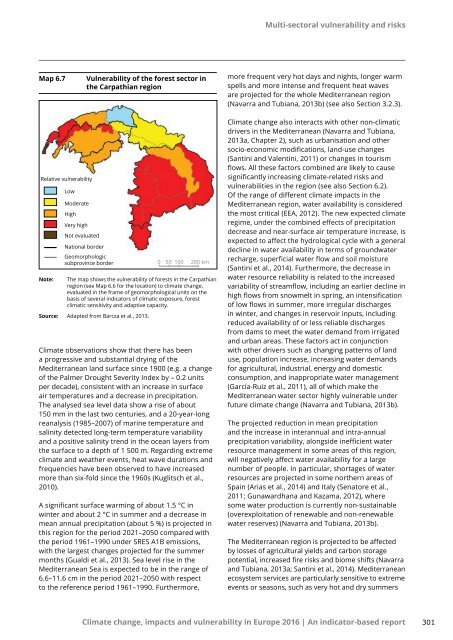Climate change impacts and vulnerability in Europe 2016
document
document
Create successful ePaper yourself
Turn your PDF publications into a flip-book with our unique Google optimized e-Paper software.
Multi-sectoral <strong>vulnerability</strong> <strong>and</strong> risks<br />
Map 6.7<br />
Vulnerability of the forest sector <strong>in</strong><br />
the Carpathian region<br />
more frequent very hot days <strong>and</strong> nights, longer warm<br />
spells <strong>and</strong> more <strong>in</strong>tense <strong>and</strong> frequent heat waves<br />
are projected for the whole Mediterranean region<br />
(Navarra <strong>and</strong> Tubiana, 2013b) (see also Section 3.2.3).<br />
Relative <strong>vulnerability</strong><br />
Note:<br />
Low<br />
Moderate<br />
High<br />
Very high<br />
Not evaluated<br />
National border<br />
Geomorphologic<br />
subprov<strong>in</strong>ce border<br />
The map shows the <strong>vulnerability</strong> of forests <strong>in</strong> the Carpathian<br />
region (see Map 6.6 for the location) to climate <strong>change</strong>,<br />
evaluated <strong>in</strong> the frame of geomorphological units on the<br />
basis of several <strong>in</strong>dicators of climatic exposure, forest<br />
climatic sensitivity <strong>and</strong> adaptive capacity.<br />
Source: Adapted from Barcza et al., 2013.<br />
0 50 100 200 km<br />
<strong>Climate</strong> observations show that there has been<br />
a progressive <strong>and</strong> substantial dry<strong>in</strong>g of the<br />
Mediterranean l<strong>and</strong> surface s<strong>in</strong>ce 1900 (e.g. a <strong>change</strong><br />
of the Palmer Drought Severity Index by – 0.2 units<br />
per decade), consistent with an <strong>in</strong>crease <strong>in</strong> surface<br />
air temperatures <strong>and</strong> a decrease <strong>in</strong> precipitation.<br />
The analysed sea level data show a rise of about<br />
150 mm <strong>in</strong> the last two centuries, <strong>and</strong> a 20-year-long<br />
reanalysis (1985–2007) of mar<strong>in</strong>e temperature <strong>and</strong><br />
sal<strong>in</strong>ity detected long-term temperature variability<br />
<strong>and</strong> a positive sal<strong>in</strong>ity trend <strong>in</strong> the ocean layers from<br />
the surface to a depth of 1 500 m. Regard<strong>in</strong>g extreme<br />
climate <strong>and</strong> weather events, heat wave durations <strong>and</strong><br />
frequencies have been observed to have <strong>in</strong>creased<br />
more than six-fold s<strong>in</strong>ce the 1960s (Kuglitsch et al.,<br />
2010).<br />
A significant surface warm<strong>in</strong>g of about 1.5 °C <strong>in</strong><br />
w<strong>in</strong>ter <strong>and</strong> about 2 °C <strong>in</strong> summer <strong>and</strong> a decrease <strong>in</strong><br />
mean annual precipitation (about 5 %) is projected <strong>in</strong><br />
this region for the period 2021–2050 compared with<br />
the period 1961–1990 under SRES A1B emissions,<br />
with the largest <strong>change</strong>s projected for the summer<br />
months (Gualdi et al., 2013). Sea level rise <strong>in</strong> the<br />
Mediterranean Sea is expected to be <strong>in</strong> the range of<br />
6.6–11.6 cm <strong>in</strong> the period 2021–2050 with respect<br />
to the reference period 1961–1990. Furthermore,<br />
<strong>Climate</strong> <strong>change</strong> also <strong>in</strong>teracts with other non-climatic<br />
drivers <strong>in</strong> the Mediterranean (Navarra <strong>and</strong> Tubiana,<br />
2013a, Chapter 2), such as urbanisation <strong>and</strong> other<br />
socio-economic modifications, l<strong>and</strong>-use <strong>change</strong>s<br />
(Sant<strong>in</strong>i <strong>and</strong> Valent<strong>in</strong>i, 2011) or <strong>change</strong>s <strong>in</strong> tourism<br />
flows. All these factors comb<strong>in</strong>ed are likely to cause<br />
significantly <strong>in</strong>creas<strong>in</strong>g climate-related risks <strong>and</strong><br />
vulnerabilities <strong>in</strong> the region (see also Section 6.2).<br />
Of the range of different climate <strong>impacts</strong> <strong>in</strong> the<br />
Mediterranean region, water availability is considered<br />
the most critical (EEA, 2012). The new expected climate<br />
regime, under the comb<strong>in</strong>ed effects of precipitation<br />
decrease <strong>and</strong> near-surface air temperature <strong>in</strong>crease, is<br />
expected to affect the hydrological cycle with a general<br />
decl<strong>in</strong>e <strong>in</strong> water availability <strong>in</strong> terms of groundwater<br />
recharge, superficial water flow <strong>and</strong> soil moisture<br />
(Sant<strong>in</strong>i et al., 2014). Furthermore, the decrease <strong>in</strong><br />
water resource reliability is related to the <strong>in</strong>creased<br />
variability of streamflow, <strong>in</strong>clud<strong>in</strong>g an earlier decl<strong>in</strong>e <strong>in</strong><br />
high flows from snowmelt <strong>in</strong> spr<strong>in</strong>g, an <strong>in</strong>tensification<br />
of low flows <strong>in</strong> summer, more irregular discharges<br />
<strong>in</strong> w<strong>in</strong>ter, <strong>and</strong> <strong>change</strong>s <strong>in</strong> reservoir <strong>in</strong>puts, <strong>in</strong>clud<strong>in</strong>g<br />
reduced availability of or less reliable discharges<br />
from dams to meet the water dem<strong>and</strong> from irrigated<br />
<strong>and</strong> urban areas. These factors act <strong>in</strong> conjunction<br />
with other drivers such as chang<strong>in</strong>g patterns of l<strong>and</strong><br />
use, population <strong>in</strong>crease, <strong>in</strong>creas<strong>in</strong>g water dem<strong>and</strong>s<br />
for agricultural, <strong>in</strong>dustrial, energy <strong>and</strong> domestic<br />
consumption, <strong>and</strong> <strong>in</strong>appropriate water management<br />
(García-Ruiz et al., 2011), all of which make the<br />
Mediterranean water sector highly vulnerable under<br />
future climate <strong>change</strong> (Navarra <strong>and</strong> Tubiana, 2013b).<br />
The projected reduction <strong>in</strong> mean precipitation<br />
<strong>and</strong> the <strong>in</strong>crease <strong>in</strong> <strong>in</strong>terannual <strong>and</strong> <strong>in</strong>tra-annual<br />
precipitation variability, alongside <strong>in</strong>efficient water<br />
resource management <strong>in</strong> some areas of this region,<br />
will negatively affect water availability for a large<br />
number of people. In particular, shortages of water<br />
resources are projected <strong>in</strong> some northern areas of<br />
Spa<strong>in</strong> (Arias et al., 2014) <strong>and</strong> Italy (Senatore et al.,<br />
2011; Gunawardhana <strong>and</strong> Kazama, 2012), where<br />
some water production is currently non-susta<strong>in</strong>able<br />
(overexploitation of renewable <strong>and</strong> non-renewable<br />
water reserves) (Navarra <strong>and</strong> Tubiana, 2013b).<br />
The Mediterranean region is projected to be affected<br />
by losses of agricultural yields <strong>and</strong> carbon storage<br />
potential, <strong>in</strong>creased fire risks <strong>and</strong> biome shifts (Navarra<br />
<strong>and</strong> Tubiana, 2013a; Sant<strong>in</strong>i et al., 2014). Mediterranean<br />
ecosystem services are particularly sensitive to extreme<br />
events or seasons, such as very hot <strong>and</strong> dry summers<br />
<strong>Climate</strong> <strong>change</strong>, <strong>impacts</strong> <strong>and</strong> <strong>vulnerability</strong> <strong>in</strong> <strong>Europe</strong> <strong>2016</strong> | An <strong>in</strong>dicator-based report<br />
301


